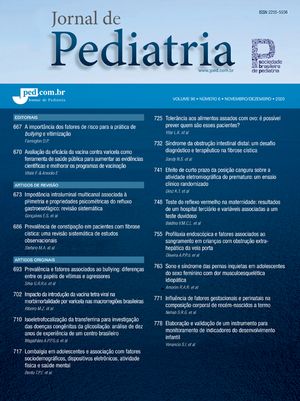
To emphasize the importance of nutrition for healthy growth and development during adolescence.
Methods: 1 - National and international bibliographic review of the main anthropometric data to be used during puberty. 2 - Description of practical questions for the evaluation of the nutritional status of adolescents. 3 - Main interventions and prevention activities for nutritional and health risk situations to be planned by the pediatrician in his professional activities with the multidisciplinary team.
ResultsAdolescence is a life period between 10 and 20 years of age, marked by intense body changes resulting from puberty and psychosocial development that influence nutritional requirements. The routine follow-up of adolescents should include the evaluation of growth velocity and sexual maturation, and also the anthropometric measures for the evaluation of the nutritional status. During the pubertal growth spurt, there is an increase in the protein, calorie, and nutrient requirements, in addition to the extras recommended for growth and for several activities, according to different life styles.
Conclusions: Dealing with adolescents consists of opening new opportunities for nutritional counseling and health education. The dissemination of healthy eating concepts is one of the basic recommendations concerning community and clinical intervention. It is also one of the pediatrician s obligations towards adolescents.
Salientar a importância da discinesia ciliar primária no diagnóstico diferencial das pneumopatias crônicas da infância.
MétodosRevisão bibliográfica dos últimos 10 anos, através do sistema Medline e procura direta.
Resultados e ConclusõesA discinesia ciliar primária é uma doença em que há alteração no transporte mucociliar, afetando o trato respiratório superior e inferior. Geralmente os sintomas são precoces, podendo evoluir para bronquiectasias. A Síndrome de Kartagener é a manifestação genética clássica. Para o seu diagnóstico podem ser feitos testes de triagem, como o teste de sacarina, porém sua confirmação exige métodos específicos e sofisticados, de estudo da ultraestrutura e da função ciliar. Diversos defeitos ultraestruturais são hoje conhecidos. O tratamento é de suporte, visando melhorar o transporte mucociliar através de fisioterapia respiratória, fazendo-se a profilaxia das infecções respiratórias através de imunizações e com o uso precoce de antimicrobianos quando indicado.









